- Home
- .
- The freight rate will increase again from April!!
The freight rate will increase again from April!!
The freight rate has just dropped slightly, the major shipping companies adjusted the freight rate, and the freight rate will increase again from April!!
Europe is experiencing the third wave of the epidemic
and many places are facing another blockade. The situation is not optimistic,
and the global economy continues to recover slowly. The availability of
containers in Chinese ports has increased. According to Container xChange data,
signs of a long-term shortage of containers in China are alleviating. Compared
with before the Spring Festival, the container availability index (CAx) of
major ports in China has increased by 56%. At present, the high level of the
transportation market has fallen, and the decline in freight rates of most
routes has begun to decline slightly. Last week, the Shanghai Shipping Exchange
released the Shanghai Export Container Freight Index of 2583.87 points, down
2.0% from the previous period.
Although the Asian container spot freight rate has fallen slightly
from the record high after the Spring Festival, the return and secondary
transaction prices continue to rise. Since April, many shipping companies have
successively announced adjustments to freight rates and various surcharges. It
seems that freight rates may increase again in April!
Decline in demand and decline in freight rates on most routes
Recently, the epidemic situation in many European countries has rebounded. France, Germany, Italy and other countries have been blocked again, which has affected the economic recovery. The most recent Baltic Sea Freight Index (Freightos Baltic Index, FBX) showed that the spot freight rate in Northern Europe was US$7,665 per 40 feet, a 4% drop from the previous period. It's even lower than the over $8,000 at the beginning of this month.
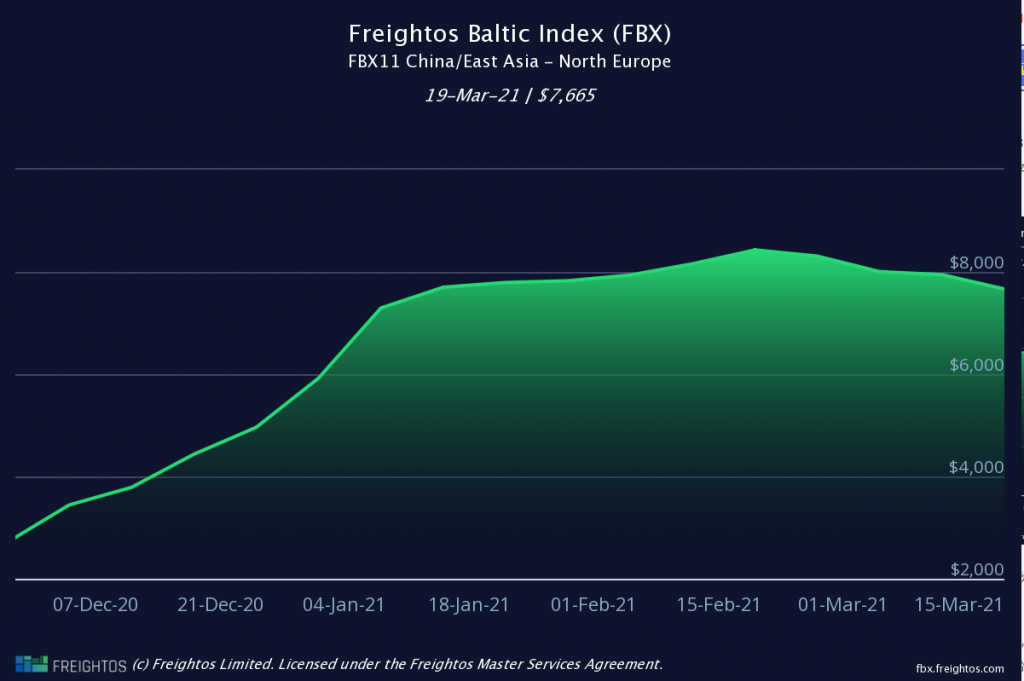
The latest SCFI index last week showed that the freight rate (sea and ocean surcharges) for exports from Shanghai to the European basic port market was 3665 US dollars/TEU, down 1.3% from the previous period.
However, the weekly FBX index of Mediterranean ports remained stable at US$8001 per 40 feet, a decrease of 1% from the previous period. The SCFI index shows that the freight rate (ocean and ocean freight surcharges) for exports from Shanghai to the Mediterranean basic port market was 3901 USD/TEU, down 3.0% from the previous period.
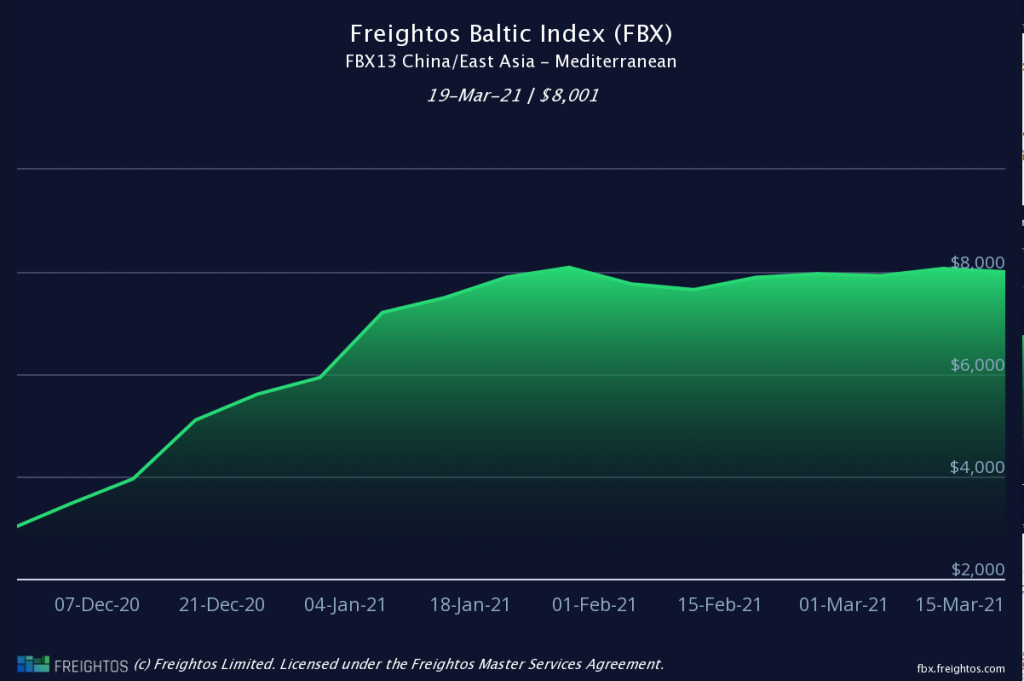
The US epidemic is showing signs of slowing down and the US economy is recovering slowly, but the demand for living supplies remains strong. The volume of incoming cargo will usher in another peak next week. Although the number of ships waiting to berth in San Peiro Bay has decreased, the waiting time has not been shortened and still reached 7.8 days. More ships have been waiting for up to two weeks

The spot freight rate from Asia to the West Coast of the United States abandoned the previous week’s increase and fell 8% to US$4,212 per 40 feet.
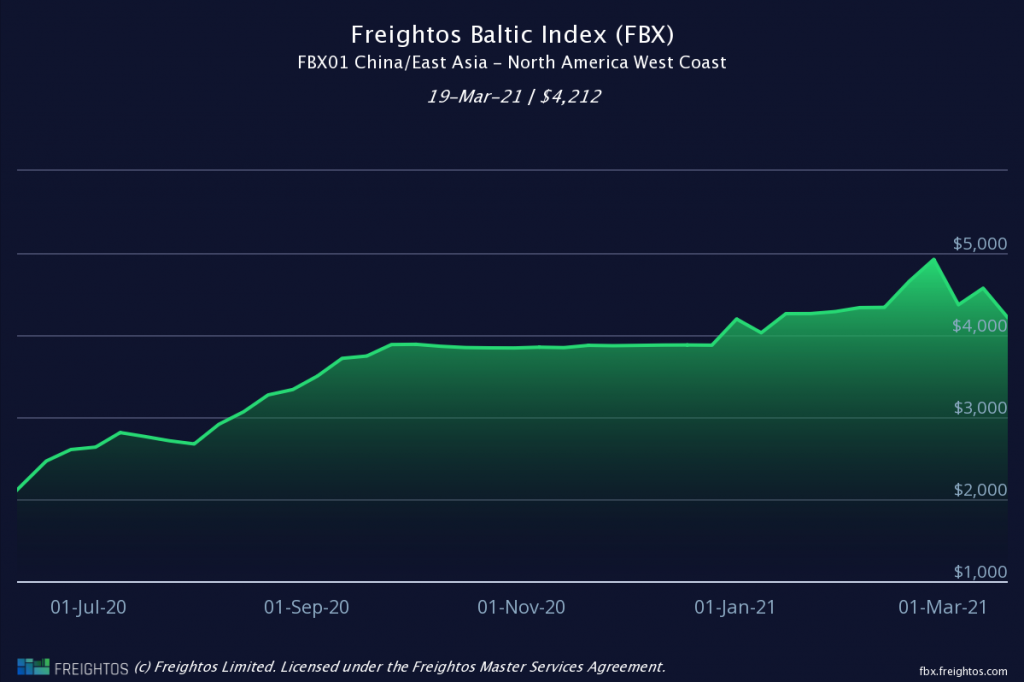
However, due to cargo owners trying to avoid the extremely congested West Coast ports of the United States, spot freight rates on the East Coast of the United States have been rising strongly, with the FBX index reaching $5,729 per 40 feet, plus a 3% increase in the first phase.
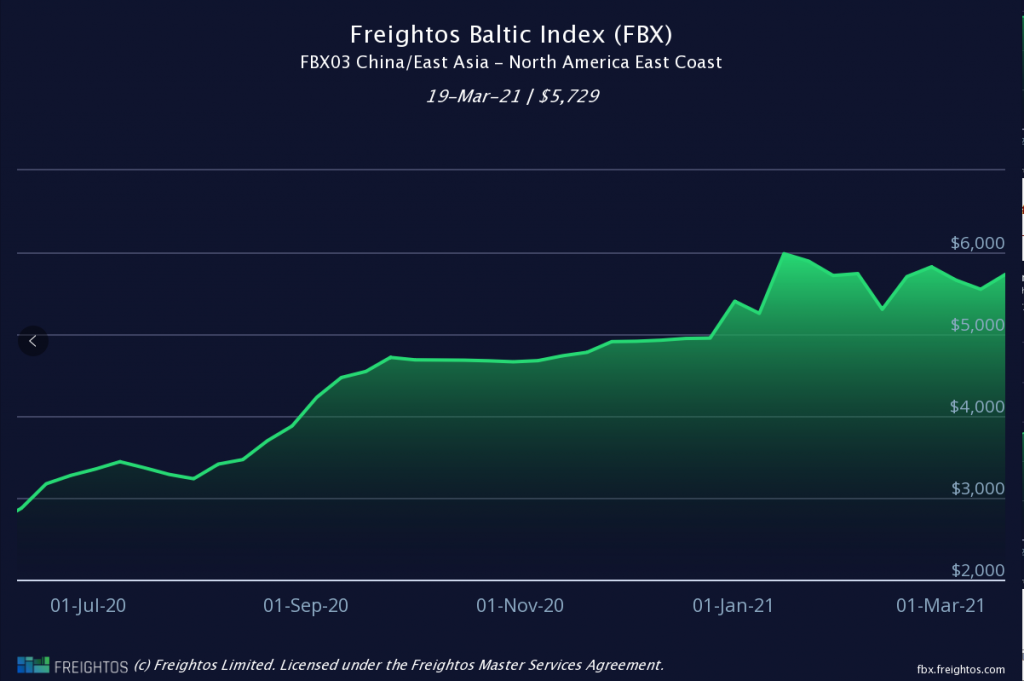
According to the SCFI index: freight rate (sea freight and ocean freight surcharge)
Persian Gulf route: The freight rate to the basic port market was US$1373/TEU, down 3.9% from the previous period.
Australia and New Zealand routes: The freight rate to the basic port market was US$2012/TEU, down 4.0% from the previous period.
Increased container availability in Chinese ports
The epidemic has rendered approximately 25 million containers unusable and freight rates have soared. Some analysts expressed pessimism that the shortage of containers and the consequent port congestion may continue until the second half of 2021. However, data from Container xChange, a container leasing and trading platform, shows that signs of a chronic shortage of containers in China are alleviating. Compared with before the Spring Festival, the container availability index (CAx) of China's major ports has increased by 56%.
Compared with before the Spring Festival, the availability index (CAx) of Shanghai's 20-foot container and 40-foot container increased by 64% and 112%, respectively.
South American route: The freight rate to the basic port market was US$6,855/TEU, down 7.0% from the previous period.
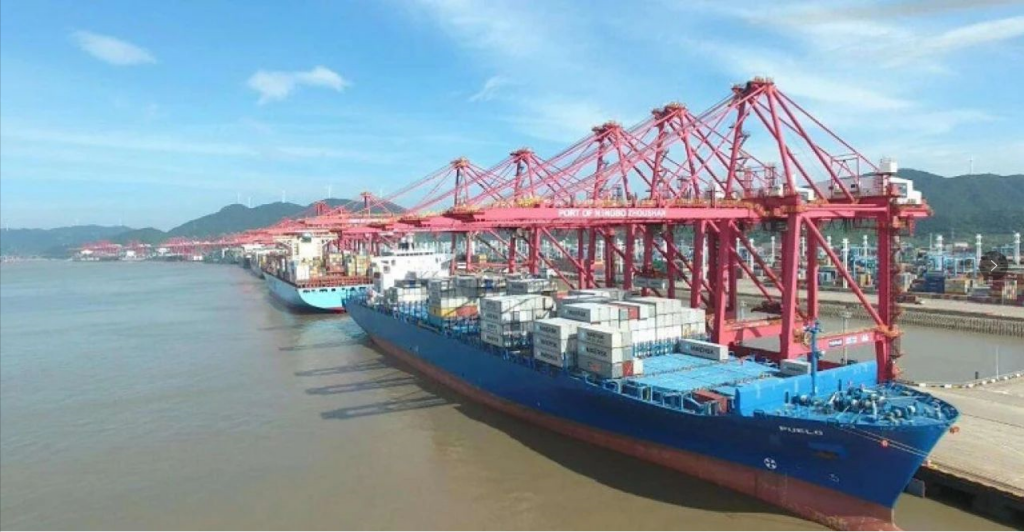
Dr. Johannes Schlingmeier, CEO and founder of Container xChange, said that although the seasonal decline in Chinese output during the Spring Festival is weaker than usual, it still helps to improve the balance of container supply and demand. According to the data of Container xChange, the container price is still at an abnormally high level, but the container price has dropped from a peak of USD 5,593 in January to USD 3,750 in February, reflecting the increase in container supply.
A CAx index lower than 0.5 means that more containers are leaving the port than entering the port, while a CAx index higher than 0.5 means that more containers are entering the port than leaving the port.
In Shanghai, Qingdao, Dalian and Ningbo ports, Dalian has the highest container availability. After the Lunar New Year, the CAx index of the 20-foot box reached 0.79, and the CAx index of the 40-foot box reached 0.80. Dalian is the only port among the four ports to enter the CAx of 20-foot and 40-foot containers above 0.5 in 2021. The availability of Dalian's containers has increased this year, but it is lower than other ports.
Schlingmeier said: “A week’s index value greater than 0.5 does not mean anything, but like Shanghai and other major ports in China, it exceeds 0.5 for several consecutive weeks. This means that eventually more containers will enter the port regularly, and this will have a chance to reduce containers. Supply and demand imbalance." "Because there are still so many supply chain disruptions, we expect container supply in China and other regions to remain unstable. But so far, there are positive signs that the availability of containers in major export centers is improving."
Major shipping companies adjust surcharges and freight rates.
MSC implements wrong declaration fee (CMD)
In the following cases, the MSC will implement an error declaration fee (CMD):
After the MSC confirms the reservation, if the rate level is lower than the original reservation level, any changes to the named account.
Discover any abuse of the contract (different from the commodity, port of loading and/or account for which the rate was originally submitted)
Misdeclaration fee (CMD) will be charged USD 1,000/container for all cargo from Cambodia, China, Hong Kong, Indonesia, Japan, South Korea, Malaysia, Myanmar, Philippines, Singapore, Taiwan, Thailand and Vietnam to the following destination ports :
To any destination other than the United States: From March 22, 2021 (the date of the bill of lading), until further notice.
To the United States: From April 20, 2021 (the date of bill of lading), further notice.

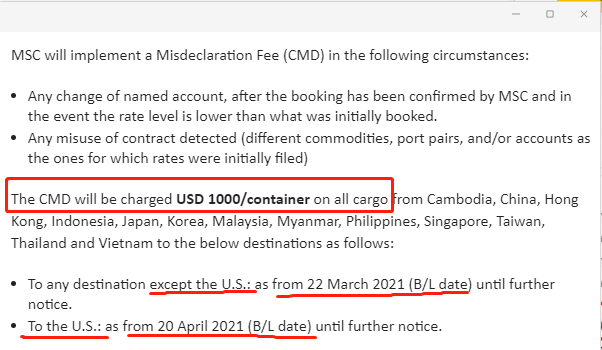
CMA CGM adjusts far east to Indian subcontinent rate I
In order to continue to provide customers with reliable and efficient services on the Asian-Indian subcontinent routes, CMA CGM has notified customers to increase the following fees:
Effective date: April 1, 2021 (bill date):
Departure port: all ports in the Far East
Port of Destination: Pakistan, West Coast of India, East Coast of India and Sri Lanka
Box type: dry box, OOG special box, bulk box and reefer box
Amount: + USD200/20' | + USD400/40'

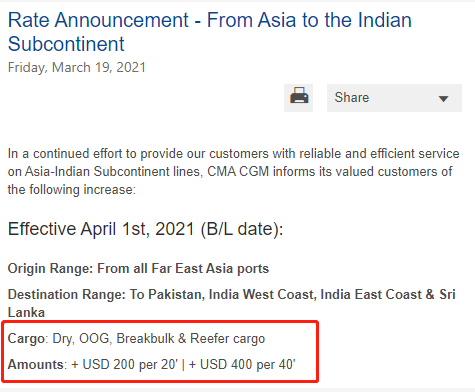
CMA CGM adjusts Asia to Cameroon Douala PSS
In order to continue to strive to provide customers with reliable and effective services, CMA CGM has notified the adjustment of peak season surcharges:
Effective date: April 1, 2021 (shipping date):
FROM: Northeast Asia, Southeast Asia, China, Hong Kong and Macao Special Administrative Region of China
TO: Douala, Cameroon
Standard: USD 150/dry box

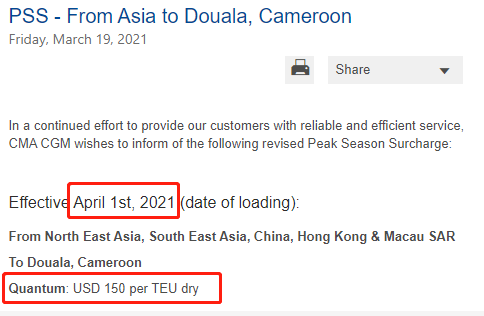
HPL adjusts Asia to Latin America ACO
Starting from April 17, 2021, Hapag-Lloyd will adjust the Arbitrary Charge Origin (ACO) for the following ports (all Chinese ports, rate increases) as follows:
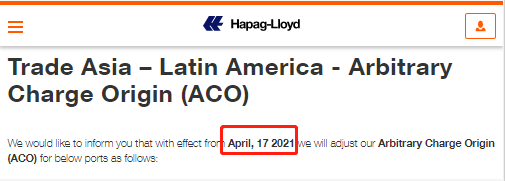
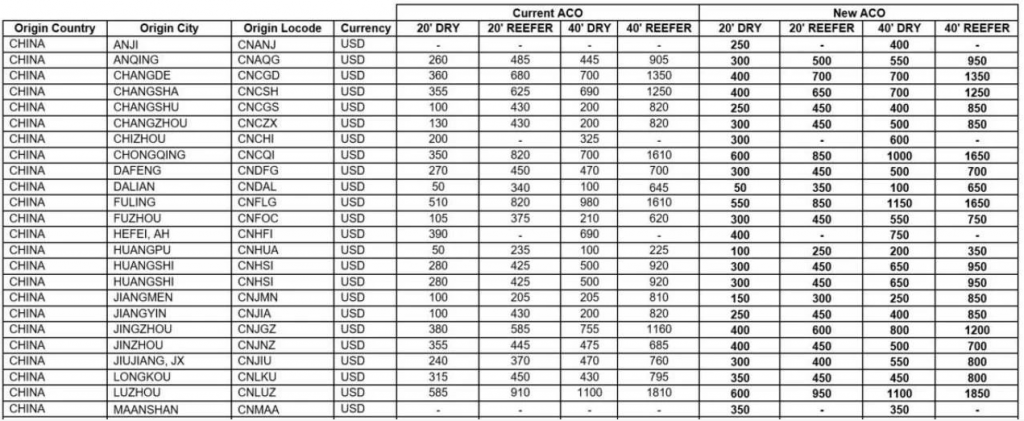
Hapag-Lloyd's characteristics receive GRI from East Asia to the U.S. and Canada
Hapag-Lloyd’s official website announced that starting from April 15, 2021 (date of cargo receipt at origin), the following GRI will be implemented on eastbound routes from East Asia to all destinations in the United States and Canada.
The GRI applies to all the following dry containers, reefer containers, non-operating reefer (Non-Operating Reefer, referred to as NOR), tank containers, flat containers and open top containers.
All 20' containers: USD 960
All 40' containers: USD 1,200
East Asia includes countries/regions in Japan, South Korea, China, Taiwan, Hong Kong, Macau, Vietnam, Laos, Cambodia, Thailand, Myanmar, Malaysia, Singapore, Brunei, Indonesia, the Philippines, and Russia’s Pacific Rim provinces.
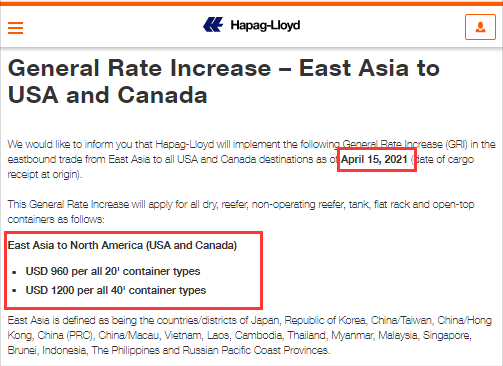
HPL adjusts prices from Turkey to East Asia
Hapag-Lloyd announced that on the eastbound trade route from Turkey to East Asia, the ocean freight rates for all 20' and 40' universal (including tall containers) containers will be increased. Applicable to voyages from April 1, 2021, until further notice, Hapag-Lloyd’s shipping rates from Turkey to East Asia are adjusted as follows:
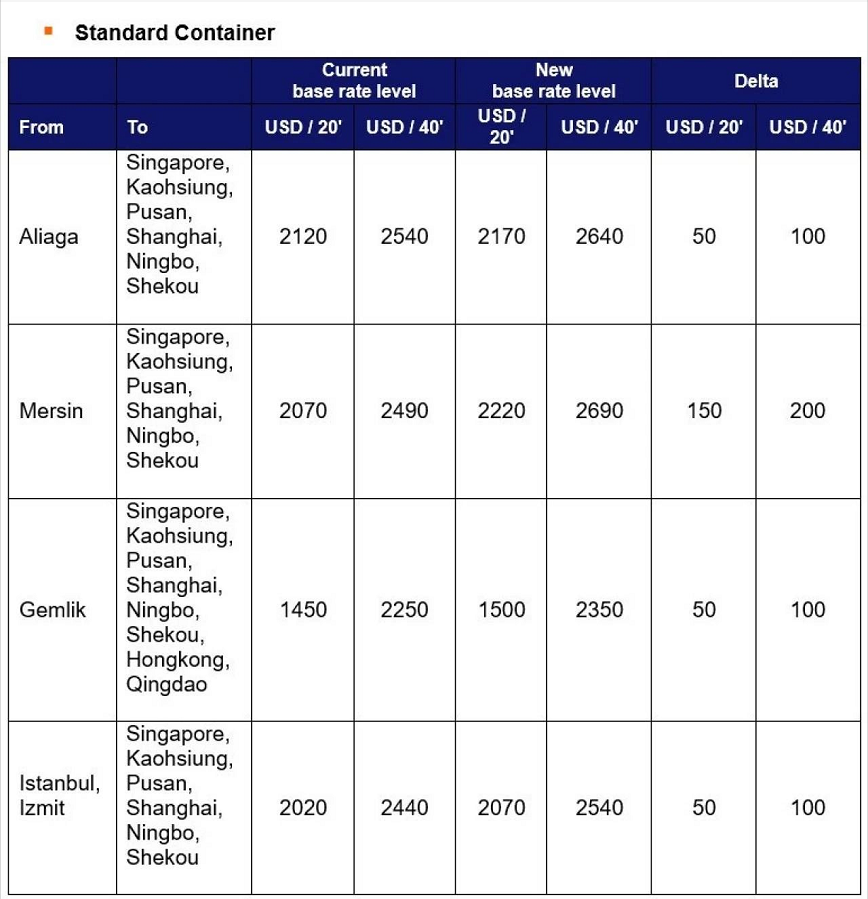
HPL adjusts prices from Italy to East Asia
Hapag-Lloyd announced that on the eastbound trade route from Italy to East Asia, the ocean freight rates for all special containers of 20' and 40' (including high containers) will be increased. Applicable to voyages starting from April 1, 2021, until further notice, H Hapag-Lloyd’s shipping rates from Italy to East Asia are adjusted as follows:
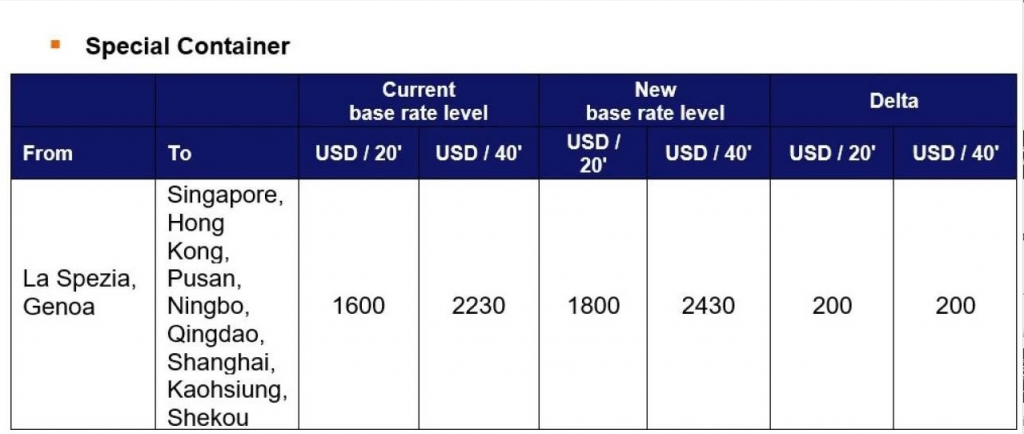
Other Related
* No related articles
